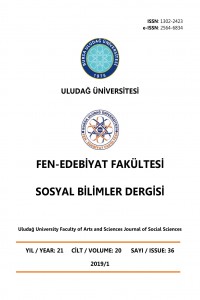Öz
travmanın nasıl tanımlandığını, tarihsel olay ve şartların sanat üzerindeki
etkisini araştırmaktadır; örneğin, Modernizm I. Dünya Savaşı sonrası ortaya
çıkan travma, yabancılaşma ve yalnızlık temalarını yansıtır. Bu bağlantı 1887
yılında doğmuş ve yirminci yüzyılın pek çok büyük olayına tanıklık etmiş Edwin
Muir’in şiirinde de görülebilir. Fakat Muir’in travma anlayışı sadece I. Dünya
Savaşı ile sınırlı değildir; aynı zamanda, insanların ve mekânların kaybı da
onun şiirini etkilemiştir. Travmayla birlikte, kayıp ve göç olayları da Muir’i
mitik ve nostaljik bir geçmişe yöneltmiştir. Başka bir şehre göç ettiği için
şairin çektiği ıstırap, belirli mekânlarla özdeşleşmiştir, bu sebeple Muir’in
şiiri mekânsal özellikler üzerinde durur. Bu bakımdan, genellikle nostalji
duygularına yol açtığı için travma Muir’in şiirini anlamak için merkezi bir rol
oynar. Muir’in nostalji anlayışıyla bağlantılı travmasının merkezinde hem
tarihsel hem de mitik bir mekânsal yoğunlaşma yer alır. Dolayısıyla bu çalışma,
Muir’in kişisel ve genel travmasına bağlı olarak nostalji ve mekân arasındaki
başlıca bağlantıyı inceleyecektir.
Anahtar Kelimeler
Kaynakça
- Bachelard, Gaston (1994). The Poetics of Space. Trans. Maria Jolas. Boston: Beacon Press.
- Butter, Peter H. (1966). Edwin Muir: Man and Poet. Edinburgh: Oliver & Boyd.
- Caruth, Cathy (1996). Unclaimed Experience: Trauma, Narrative, and History. Baltimore: The Johns Hopkins UP.
- Eliade, Mircea (1961). Images and Symbols: Studies in Religious Symbolism. Trans. Philip Mairet. New York: Sheed & Ward.
- Hall, John Clive (1956). Edwin Muir. London: Longmans, Green & Co.
- Hoffman, Daniel (1967). Barbarous Knowledge: Myth in the Poetry of Yeats, Graves, and Muir. New York: Oxford UP.
- Huberman, Elizabeth (1972). “Initiation and Tragedy: A New Look at Edwin Muir’s ‘The Gate’”, PMLA, Vol. 87, Iss. 1, p. 75-79.
- ---------------------------- (1971). The Poetry of Edwin Muir: The Field of Good and Ill. New York: Oxford U P.
- Kaplan, E. Ann (2005). Trauma Culture: The Politics of Terror and Loss in Media and Literature. New Brunswick: Rutgers UP.
- Macrae, Alasdair D. F. (1995). “Edwin Muir: Reading Eternity’s Secret Script” British Poetry, 1900-50: Aspects of Tradition. Eds. Gary Day and Brian Docherty. Basingstoke: Macmillan P.
- Muir, Edwin (1954). An Autobiography. London: The Hogarth Press.
- ----------------- (1960). Collected Poems: 1921-1958. London: Faber and Faber.
- Trauma (1993). Webster’s Third New International Dictionary. 3rd ed., p. 2432.
- Tuan, Yi-Fu (1977). Space and Place: The Perspective of Experience. Minneapolis: U of Minnesota P.
- van der Kolk, Bassel A. and Onno van der Hart (1995). “The Intrusive Past: The Flexibility of Memory and the Engraving of Trauma” Trauma: Explorations in Memory. Ed. Cathy Caruth. Baltimore: The Johns Hopkins UP., p. 158-182.
Öz
Trauma studies have recently explored the influence of historical event
and circumstance on art and how trauma is portrayed; for example, Modernism
represents the embodiment of the theme of trauma, alienation and loneliness
after the First World War. This connection is also discernible in the poetry of
Edwin Muir who was born in 1887 and witnessed various great events of the
twentieth century. However, Muir’s sense of trauma was not limited to only WWI,
but the loss of people and places influenced his verse as well. The theme of
loss and migration led Muir to a mythical and nostalgic past as a response to
trauma. Due to migration to another city, his struggle with agony was blended
with certain places; hence, his poetry elaborates on spatial aspects. In this
regard, as it often does lead to feelings of nostalgia, trauma becomes central
to understanding Muir’s poetry. In the centre of Muir’s trauma related to his
abiding sense of nostalgia is a concentration on places, both historical and
mythical. Therefore, this paper will explore the main connection between
nostalgia and space in relation to Muir’s personal and collective trauma.
Anahtar Kelimeler
Kaynakça
- Bachelard, Gaston (1994). The Poetics of Space. Trans. Maria Jolas. Boston: Beacon Press.
- Butter, Peter H. (1966). Edwin Muir: Man and Poet. Edinburgh: Oliver & Boyd.
- Caruth, Cathy (1996). Unclaimed Experience: Trauma, Narrative, and History. Baltimore: The Johns Hopkins UP.
- Eliade, Mircea (1961). Images and Symbols: Studies in Religious Symbolism. Trans. Philip Mairet. New York: Sheed & Ward.
- Hall, John Clive (1956). Edwin Muir. London: Longmans, Green & Co.
- Hoffman, Daniel (1967). Barbarous Knowledge: Myth in the Poetry of Yeats, Graves, and Muir. New York: Oxford UP.
- Huberman, Elizabeth (1972). “Initiation and Tragedy: A New Look at Edwin Muir’s ‘The Gate’”, PMLA, Vol. 87, Iss. 1, p. 75-79.
- ---------------------------- (1971). The Poetry of Edwin Muir: The Field of Good and Ill. New York: Oxford U P.
- Kaplan, E. Ann (2005). Trauma Culture: The Politics of Terror and Loss in Media and Literature. New Brunswick: Rutgers UP.
- Macrae, Alasdair D. F. (1995). “Edwin Muir: Reading Eternity’s Secret Script” British Poetry, 1900-50: Aspects of Tradition. Eds. Gary Day and Brian Docherty. Basingstoke: Macmillan P.
- Muir, Edwin (1954). An Autobiography. London: The Hogarth Press.
- ----------------- (1960). Collected Poems: 1921-1958. London: Faber and Faber.
- Trauma (1993). Webster’s Third New International Dictionary. 3rd ed., p. 2432.
- Tuan, Yi-Fu (1977). Space and Place: The Perspective of Experience. Minneapolis: U of Minnesota P.
- van der Kolk, Bassel A. and Onno van der Hart (1995). “The Intrusive Past: The Flexibility of Memory and the Engraving of Trauma” Trauma: Explorations in Memory. Ed. Cathy Caruth. Baltimore: The Johns Hopkins UP., p. 158-182.
Ayrıntılar
| Birincil Dil | İngilizce |
|---|---|
| Konular | Sanat ve Edebiyat |
| Bölüm | Makaleler |
| Yazarlar | |
| Yayımlanma Tarihi | 31 Ocak 2019 |
| Yayımlandığı Sayı | Yıl 2019 Cilt: 20 Sayı: 36 |

This work is licensed under a Creative Commons Attribution 4.0 International License.

